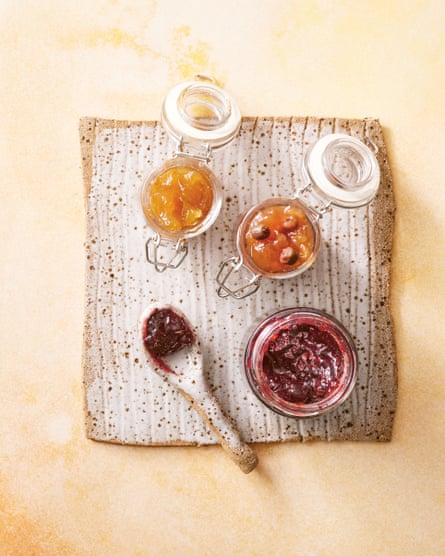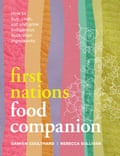There is nothing better than seeing the excitement and happiness on a child’s face when they are greeted with food. Our son Mallee is a willing consumer of all foods, especially First Nations foods, and he’s always happy to discover a new or unfamiliar flavour.
From an early age, Mallee’s introduction to native foods has been an open lunchbox. My parents and family share harvested foods from Country, and when we receive a new package from a harvester, grower or farmer, Mallee is almost always the first to try. Muntries and quandongs, eaten handfuls at a time, are his favourite.
With every handful comes an opportunity to share stories through a First Nations lens. It’s this sense of adventure, discovery and wonder that my wife Rebecca Sullivan and I hope to share.

Over the past decade there has been a rapid growth in the native foods industry: First Nations foods are now front and centre at gin distilleries and featured on menus at local cafés and top restaurants in most major cities. Native botanicals that have provided health and wellness for diverse nations over many generations are new-but-old flavours for some.
It is exciting to see Aboriginal and non-Aboriginal businesses celebrating cultural heritage through their chosen products, but many native species are significant to their place and community, and it’s important that this cultural and intellectual property remains with traditional owners.
As I get older, learning more about my culture has become a matter of urgency. Across Australia, Aboriginal languages are at great risk, with some already on the brink of no return and many extinct. As we lose languages, we also lose histories and family heritage; important knowledge systems left to sleep in the land. I see our foods as an equally important element of these systems.
Wyrrung (Rosella)
Hibiscus sabdariffa
While this plant is not technically endemic to Australia, it has been here for long enough to be treated as native. Known as wyrrung by Aboriginal people in New South Wales, the rosella (sometimes called native hibiscus) is known for enlivening pots of tea or glasses of champagne. This vibrant red flower is very versatile and is good in both sweet and savoury dishes.
Use: As you would sorrel, lemon sorrel or rhubarb. Can be eaten fresh, cooked or preserved in syrups or similar. The leaves are also delicious.
Buy: Fresh, frozen or as a freeze-dried powder. Sometimes available from farmers’ markets.
Pick/forage: As with all foraging, check the identity of the plant at least three times. Always ask permission if on someone else’s property and avoid roadsides because of pollution. Most importantly, be respectful, both culturally and environmentally. Take only what you need, and leave plenty behind for the birds and the bees.
Store: In the fridge or freezer. If dried, in an airtight container.

Rosella jam
This jam is delightful on toast and makes an ace relish to go with a cheeseboard too, and it’s swell in jam tarts. You’ll need four one-cup sterilised jars.
Makes 1 litre (4 cups)
2 kg rosella flowers, fresh
6 lemon myrtle leaves
1 cup white sugar per cup of pulp (220g)
Separate rosella petals from seed pods. Keeping them apart, wash and shake dry.
Place pods in a heavy-based saucepan and cover with around two litres of water. Boil over medium-high heat for 30 minutes.
Place petals in another saucepan. Strain juice from boiled pods directly over the petals, then discard pods. Add lemon myrtle leaves, and bring slowly to the boil over medium heat, then boil for 20 minutes until reduced by one-third. Remove from heat.
Measure the petal pulp, and add one cup of sugar (220g) for every cup of pulp, stirring to dissolve. Place over high heat and boil for 20 minutes or until setting point is reached (see note). Cool briefly, then remove lemon myrtle leaves and transfer jam to sterilised jars and seal. Jam will store in a cool, dark place for up to two years.
Note: To test for setting point, the easiest thing to do is buy a jam thermometer and when it reads 105C, your jam will set. Or you could try the saucer test. Place a few saucers in the fridge before you make your jam. When the jam has been cooking for the time stated in the recipe, drop less than a teaspoon on a cold saucer, leave for a minute then gently push your finger through the middle. If the jam crinkles, it’s reached setting point; if it doesn’t, boil for five minutes more, then test again with another cold saucer.
Urti or Bidjigal (Quandong)
Santalum acuminatum
Often referred to as native or desert peach, quandongs are one of the more common fruits in our pantry and are relatively easy to source. Known as urti in parts of South Australia and bidjigal in parts of Victoria, we always look forward to their season, and to seeing what colours they come in – from bright pink to dark pink and ruby red. We’ve also heard stories of “ghost quandong”, which are pure white.
Quandongs are popular for their tart flesh and for the kernel inside, which is sometimes used decoratively. They also hold an important place in Damien’s culture, being the jewel of the Flinders Ranges where his Country is, and in many of his Yarta Mudra (history and creation stories). The kernel is delicious – it tastes like an almond — and is highly medicinal. Quandong is also known as wolgol in Noongar (south-western WA) and as kurti in Nukunu (Yorke Peninsula, SA).
Use: As you might peaches or rhubarb — fresh, cooked or preserved.
Buy: Fresh, frozen or dried in halves or pieces. Occasionally found at farmers’ markets and shops in the right regions.
Pick/forage: Pick when the fruit has turned pink or red. Depending on where you live, this will be between October and March.
Store: In the fridge or freezer, or in an airtight container if dried. They’ll last a long time dried and will quickly plump up again when soaked.
Quandong jam
This recipe is easy and can be made with dried, fresh or frozen fruit. If you’re using dried fruit, we would recommend soaking it in water for a few hours beforehand to rehydrate it. For frozen fruit, you won’t need as much liquid in the pan as it will thaw out as you cook. If you prefer a sweeter jam, use the same weight of sugar as fruit. Feel free to add some native spices like lemon, cinnamon or anise myrtle leaves (about four to six); remove before pouring into jars.
Makes 1 litre (4 cups)
1kg quandongs, halved, seeds removed and reserved
2 cups orange juice, (500ml)
750g caster sugar
Place quandongs in a wide, heavy-based saucepan, cover with orange juice (top up with water if juice isn’t covering all the fruit) and leave to sit for up to an hour.
Heat sugar in a microwave or low oven until warm to the touch. Once the fruit has begun to soften, transfer into a saucepan with juice and place over low heat. Add sugar slowly, stirring to dissolve. Bring to a rapid boil and boil, stirring often to stop it sticking, for 10 minutes.
Allow to cool for 10 minutes before pouring into sterilised jars. Store in a cool dark place for up to a year.

Pickled quandongs
Apart from quandongs, this base recipe can also be used to pickle Tanami or other bush apples, as well as firm vegetables such as cauliflower, carrots, fennel or cabbage. Use this as you would any other pickle, with cheese, cold meats or in salads.
Makes 2 large jars (500ml each)
1.2 kg quandongs, halved, seeds removed
2 cups apple cider vinegar (500ml)
1 cup white vinegar (250ml)
1 cup white sugar (220g)
4 anise myrtle leaves
2 tsp yellow mustard seeds
1 tsp black mustard seeds
1 tsp ground turmeric
½ tsp fennel seeds
½ tsp pepperberries
Place quandongs in a large heatproof bowl. Combine remaining ingredients in a large saucepan, bring to the boil and simmer for 20 minutes or until sugar dissolves and flavours are infused.
Pour liquid over quandongs, stand for five minutes, then transfer apples and liquid back to saucepan and simmer for a further three minutes. Ladle into sterilised jars, seal and cool. Jam can be stored in a cool, dark place for up to two years. For best results, let the pickle mature for at least three months before eating.

-
This is an edited extract from the First Nations Food Companion by Damien Coulthard and Rebecca Sullivan, photography by Josh Geelen. Available now from Murdoch Books ($49.99).
Stay connected with us on social media platform for instant update click here to join our Twitter, & Facebook
We are now on Telegram. Click here to join our channel (@TechiUpdate) and stay updated with the latest Technology headlines.
For all the latest Lifestyle News Click Here
